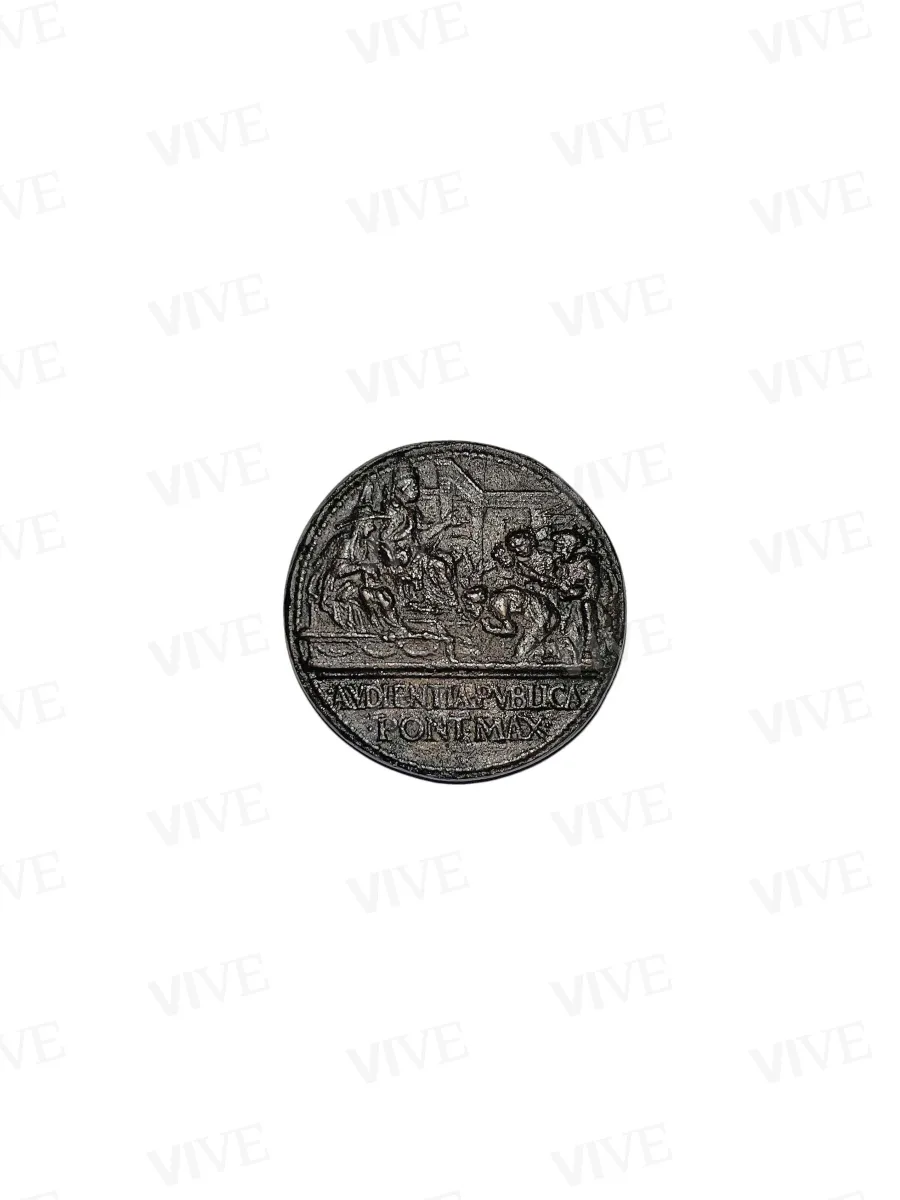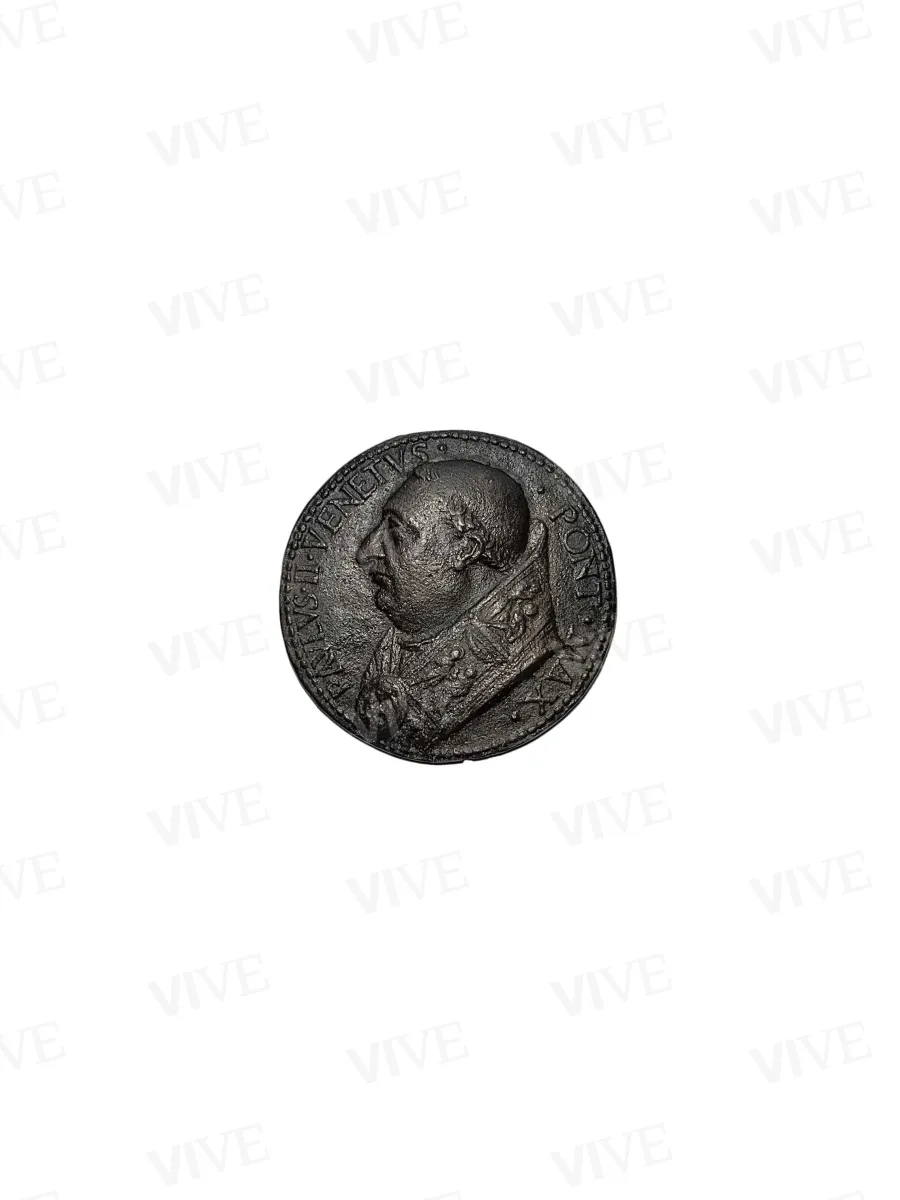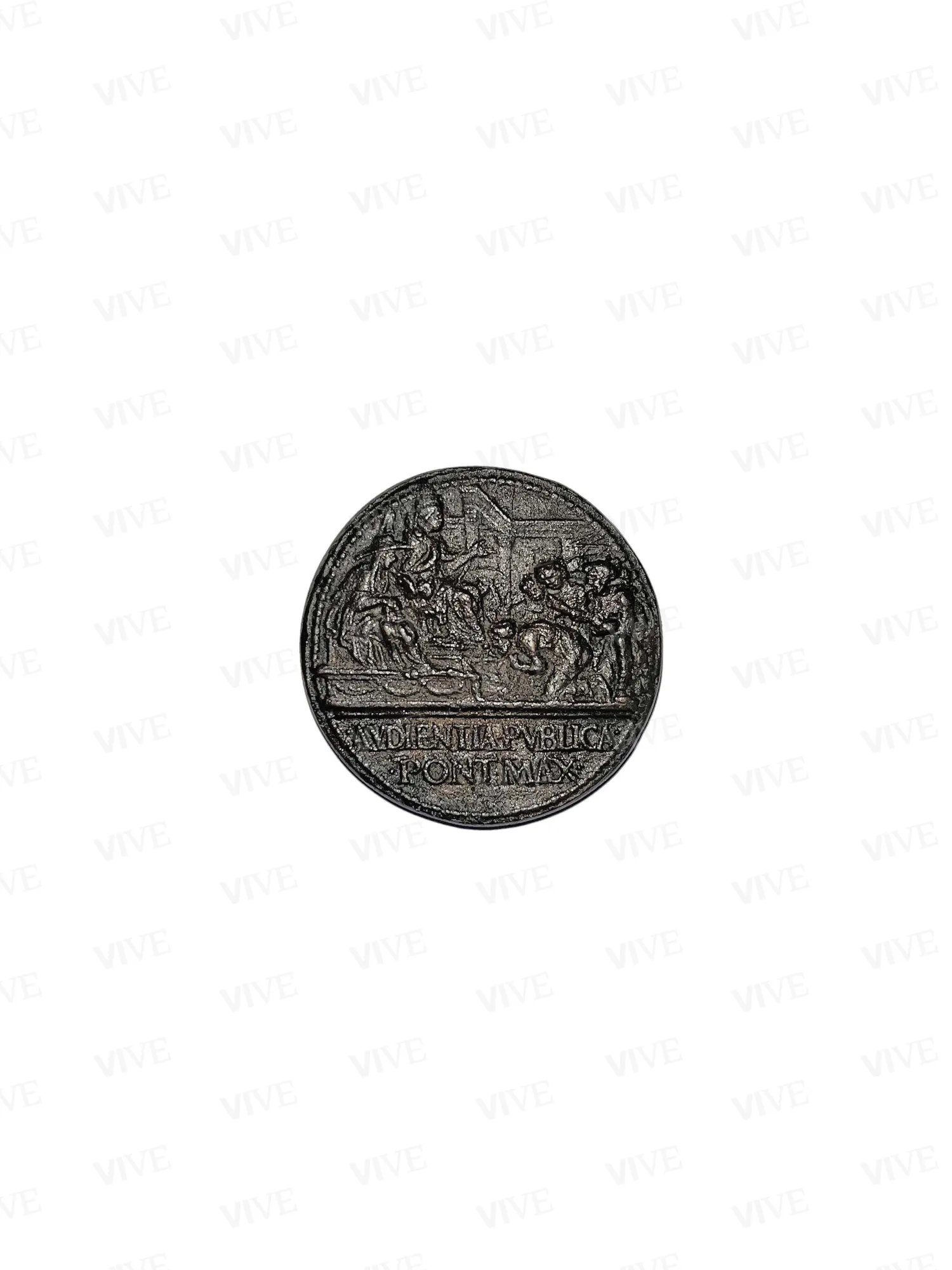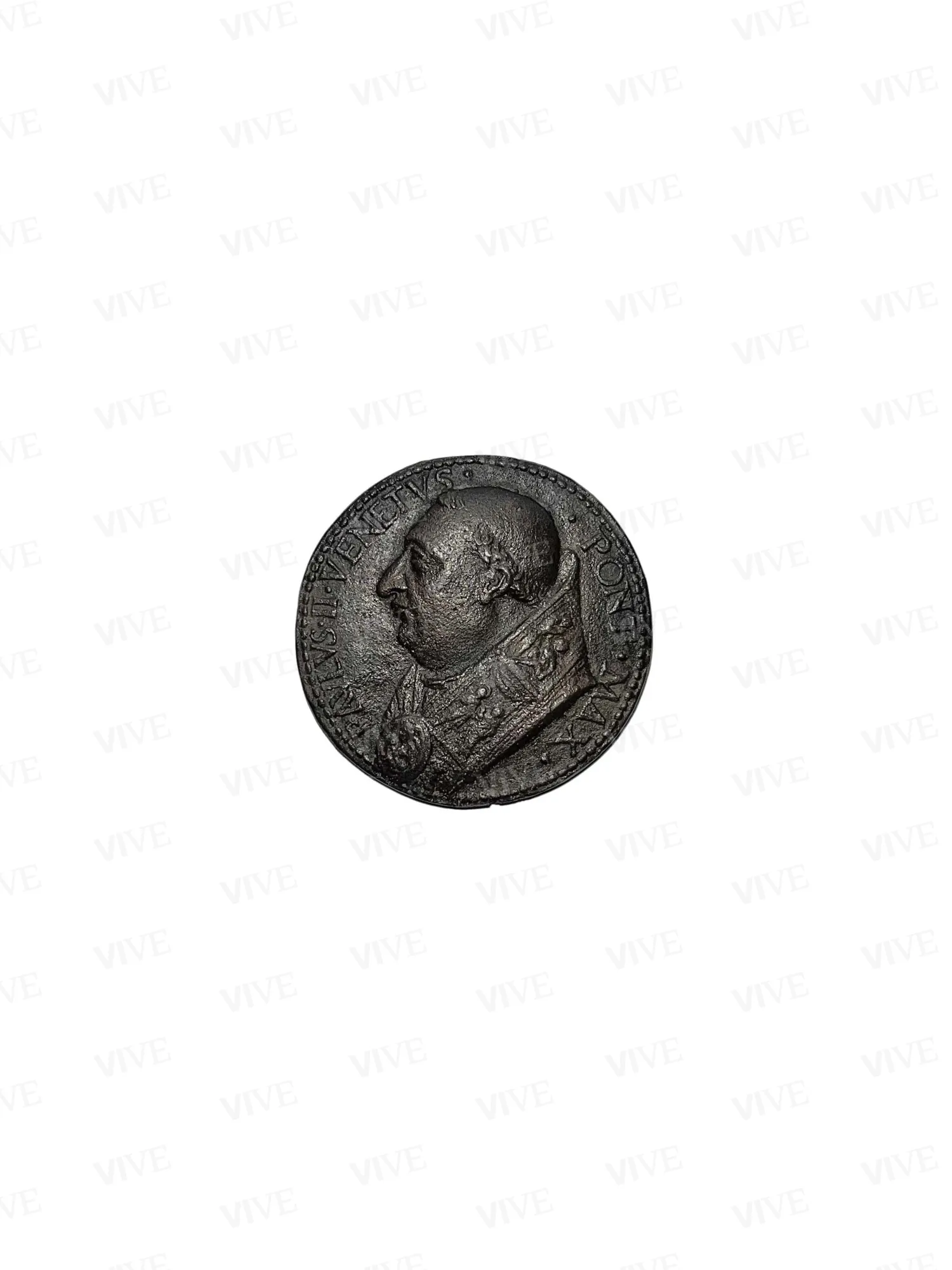Medal with Pope Paul II / The pontiff receives the faithful
Cristoforo di Geremia 1469
This medal, created by Cristoforo di Geremia from Mantua, depicts Pope Paul II and was produced for one of the numerous public audiences held by the pontiff, as illustrated on the reverse. Likely cast in 1469, similar to another medal of the same design, it portrays the heavy-set features of Paul II, which had been affected by his advanced age and indulgent lifestyle.
This medal, created by Cristoforo di Geremia from Mantua, depicts Pope Paul II and was produced for one of the numerous public audiences held by the pontiff, as illustrated on the reverse. Likely cast in 1469, similar to another medal of the same design, it portrays the heavy-set features of Paul II, which had been affected by his advanced age and indulgent lifestyle.
Details of work
Catalog entry
The obverse of the medal features the bust of Paul II, Pope from 1464, facing left. He is depicted with a tonsure and a cope adorned on its edge with two panels: the first shows Saints Peter and Paul standing side by side, and the second, positioned higher up, illustrates Peter healing a cripple. Above these panels is a large medallion depicting Madonna and Child. The reverse of the medal is almost bipartite, featuring a large border containing the legend. In the upper section, there is a high throne elevated on a step decorated with garlands of foliage, where a cardinal is seated, his head covered by his cardinal’s hat. Positioned above him is the pope wearing the papal tiara, extending his left arm towards a group of faithful paying homage. The first among them is kneeling to kiss his feet, while others stand ready to approach and bow in his presence. An architectural backdrop with columns supporting an entablature completes the scene (Hill 1910, pp. 358–359; Hill 1930, p. 200, n. 776; Modesti 2002, pp. 297–298, n. 111).
On the reverse side, the bust of the pope is similar to that of the 1469 medal (inv. 3169), created by Cristoforo di Geremia (Balbi De Caro 1973, p. 28). The primary differences are the complexity of the edge of the cope and the decorative button that fastens it, which features the Madonna and Child.
On the other side of the coin lies the gestatorial chair observed by Antonio de' Rossi, ambassador of the Duke of Milan. During one of the pontiff's public appearances, he remarked with astonishment that the ceremonial throne was so opulent and elaborate that its cost surpassed that of a palace itself. He noted that Barbo exhibited an “intolerable manner and pomp” (Fumi 1911, p. 119).
The scene depicts one of the public audiences granted by the pope to the Roman people. It is possible that some examples of the medal were distributed to attendees on these occasions, serving as devotional objects commemorating the event (Buonanni 1699, pp. 75–76, n. VI). Other examples were found in 1876 in the money boxes of foundations at the Palazzo Venezia, along with other types of medals commissioned by the pope (Balbi De Caro 1973, p. 25).
The same medal is also recognized by different legends on the reverse: “CONSISTORIVM PVBLICVM,” referring to the consistories held by Paul II (Zaccariotto 2020, p. 117, n. 89), and “SACER SENATVS,” which potentially commemorates a particular public audience conducted by the college of cardinals (Modesti 2002, pp. 302–302, n. 113).
Cristoforo di Geremia, the son of a goldsmith, was born in Mantua around 1410 and relocated to Rome in 1456. He initially served Cardinal Ludovico Scarampi Mezzarota and later Ludovico Gonzaga, who was also from Mantua. From 1465, he was employed by Pope Paul II, during which time he created several medals, signing some of them, and restored the bronze statue of Marcus Aurelius in 1468 for Emperor Frederick III's visit to Rome. He died in Rome in 1476 (Pirzio Biroli Stefanelli 1985).
Giulia Zaccariotto
Entry published on 27 March 2025
State of conservation
Good.
Inscriptions
Obverse: [within border, within beaded border] “PAVLVS • II • VENETVS • • PONT[ifex] • MAX[imus] •”;
Reverse: [within beaded border, in exergue] “• AVDIENTIA • PVBLICA • / • PONT[ifex] • MAX[imus]”
Provenance
Purchased from Scipione Buonfili, 1920;
Rome, Museo Nazionale di Palazzo Venezia, 1920.
References
Buonanni Filippo, Numismata Pontificum Romanorum quae a tempore Martini V usque ad annum MDCXCIX vel authoritate publica, vel privato genio in lucem prodiere, Romae 1699;
Hill George Francis, The Medals of Paul II, in «Numismatic Chronicle», s. 4, X, 1910, pp. 340-369;
Fumi Luigi, Eretici in Boemia e fraticelli in Roma nel 1466, in «Archivio della Regia Società romana di storia patria», XXXIV, 1911, pp. 117-130;
Hill George Francis, A Corpus of Italian Medals of the Renaissance before Cellini, 2 voll., London 1930;
Weiss Roberto, Un umanista veneziano. Papa Paolo II, Venezia 1958;
Balbi De Caro Silvana, Le medaglie del Museo del Palazzo di Venezia in Roma, in «Medaglia», 1, 1971, 2, pp. 7-15;
Balbi De Caro Silvana, Di alcune medaglie di Paolo II rinvenute nelle mura del Palazzo di Venezia in Roma, in «Medaglia», III, 1973, 5, pp. 24-34;
Pirzio Birolli Stefanelli Lucia, Cristoforo di Geremia, ad vocem, in Dizionario Biografico degli Italiani, XXXI, Roma 1985;
Modesti Adolfo, Corpus numismatum omnium Romanorum Pontificum. I. Da San Pietro (42-67) a Adriano VI (1522-1523), Roma 2002;
Cannata Pietro, Cultura e nostalgia dell’antico: collezioni e raccolte di bronzi al Palazzo di Venezia, in Cannata Pietro (a cura di), Museo Nazionale del Palazzo di Venezia. Sculture in bronzo, Roma 2011, pp. 15-30;
Zaccariotto Giulia, La collezione di medaglie Mario Scaglia. Catalogo, Cinisello Balsamo 2020.














